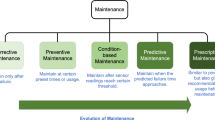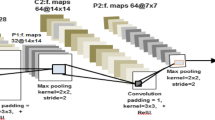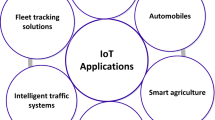Abstract
The cloud-based resources can accommodate massive energy sources and the main challenge arises when processing the terminal nodes associated with the Internet of Things (IoT). The main challenge the cloud faces when satisfying the user requests is the long delay, large bandwidth, and resource-constrained devices not capable of processing computational needs. These challenges are overcome in this work by using fog computing to process a wide range of IoT requests and workloads near the end user. The main motivation of this work is to enhance the intelligent task offloading decision by achieving a tradeoff between Quality of Service (QoS) and power consumption for a large number of mobile and fog nodes. This paper proposes an Adaptive Deep Belief Network (ADBN) that uses the Hybrid Bayesian Search and Lichtenberg Optimization (BSI-LO) technique to solve this complexity. The hybrid BSI-LO optimized ADBN architecture minimizes the energy consumption of fog devices operating on the network edge by taking different parameters such as battery lifetime, delay, workload, and power consumption into consideration and offers an effective intelligent task allocation decision. In this way, the proposed model handles a large number of requests raised in the IoT-Fog cloud network by efficient resource allocation. The hybrid BSI-LO algorithm is implemented to mutually optimize the resource allocation and offloading strategy. The experimental results confirm that the proposed methodology is effective in terms of improving the bandwidth, task weight cost, energy consumption, delay, and system utility of edge devices resulting in an efficient energy-saving strategy for the IoT-Fog-cloud architecture.











Similar content being viewed by others
Availability of data and material
Data sharing is not applicable to this article as no new data were created or analyzed in this study.
Code availability
Not applicable.
References
Gokhale P, Bhat O, Bhat S (2018) Introduction to IOT. Int Adv Res J Sci Eng Technol 5(1):41–44
Peddoju SK, Upadhyay H (2020) Evaluation of IoT data visualization tools and techniques. In Data visualization. Springer, Singapore, pp 115–139
Fu JS, Liu Y, Chao HC, Bhargava BK, Zhang ZJ (2018) Secure data storage and searching for industrial IoT by integrating fog computing and cloud computing. IEEE Trans Ind Inf 14(10):4519–4528
Gupta BB, Quamara M (2020) An overview of Internet of Things (IoT): Architectural aspects, challenges, and protocols. Concurren Comput Practice Exp 32(21):e4946
Khanagha S, Ansari S, Paroutis S, Oviedo L (2022) Mutualism and the dynamics of new platform creation: a study of cisco and fog computing. Strateg Manag J 43(3):476–506
Abbasi M, Mohammadi Pasand E, Khosravi MR (2020) Workload allocation in iot-fog-cloud architecture using a multi-objective genetic algorithm. J Grid Comput 18(1):43–56
Gu Y, Chang Z, Pan M, Song L, Han Z (2018) Joint radio and computational resource allocation in IoT fog computing. IEEE Trans Veh Technol 67(8):7475–7484
Venticinque S, Amato A (2019) A methodology for deployment of IoT application in fog. J Ambient Intell Humaniz Comput 10(5):1955–1976
Abedin SF, Alam MGR, Kazmi SA, Tran NH, Niyato D, Hong CS (2018) Resource allocation for ultra-reliable and enhanced mobile broadband IoT applications in fog network. IEEE Trans Commun 67(1):489–502
Jia B, Hu H, Zeng Y, Xu T, Yang Y (2018) Double-matching resource allocation strategy in fog computing networks based on cost efficiency. J Commun Netw 20(3):237–246
Abbasi M, Mohammadi-Pasand E, Khosravi MR (2021) Intelligent workload allocation in IoT–Fog–cloud architecture towards mobile edge computing. Comput Commun 169:71–80
Li C, Cai Q, Zhang C, Ma B, Luo Y (2021) Computation is offloading and service allocation in mobile edge computing. J Supercomput 77(12):13933–13962
Dubey K, Sharma SC, Kumar M (2022) A secure IoT applications allocation framework for integrated fog-cloud environment. J Grid Comput 20(1):1–23
Singh P, Singh R (2022) Energy-efficient delay-aware task offloading in fog-cloud computing system for IoT sensor applications. J Netw Syst Manage 30(1):1–25
Yan P, Choudhury S (2021) Deep Q-learning enabled joint optimization of mobile edge computing multi-level task offloading. Comput Commun 180:271–283
Zhu X, Zhou M (2021) Multiobjective optimized cloudlet deployment and task offloading for mobile-edge computing. IEEE Internet Things J 8(20):15582–15595
Yang S, Li F, Shen M, Chen X, Fu X, Wang Y (2019) Cloudlet placement and task allocation in mobile edge computing. IEEE Internet Things J 6(3):5853–5863
Chen X, Liu G (2021) Energy-efficient task offloading and resource allocation via deep reinforcement learning for augmented reality in mobile edge networks. IEEE Internet Things J 8(13):10843–10856
Li C, Cai Q, Zhang C, Ma B, Luo Y (2021) Computation offloading and service allocation in mobile edge computing. J Supercomput 77(12):13933–13962
Ibrokhimov B, Hur C, Kim H, Kang S (2021) A-DBNF: adaptive deep belief network framework for regression and classification tasks. Appl Intell 51(7):4199–4213
Wang Z, Zeng Y, Liu Y, Li D (2021) Deep belief network integrating improved kernel-based extreme learning machine for network intrusion detection. IEEE Access 9:16062–16091
Pereira JLJ, Francisco MB, Diniz CA, Oliver GA, Cunha SS Jr, Gomes GF (2021) Lichtenberg algorithm: a novel hybrid physics-based meta-heuristic for global optimization. Expert Syst Appl 170:114522
Mortazavi A (2021) Bayesian interactive search algorithm: a new probabilistic swarm intelligence tested on mathematical and structural optimization problems. Adv Eng Softw 155:102994
Lu H, Jin L, Luo X, Liao B, Guo D, Xiao L (2019) RNN for solving perturbed time-varying underdetermined linear system with double bound limits on residual errors and state variables. IEEE Trans Ind Inf 15(11):5931–5942
Li Z, Li S, Luo X (2021) An overview of calibration technology of industrial robots. IEEE/CAA J Automatica Sinica 8(1):23–36
Li Z, Li S, Bamasag OO, Alhothali A, Luo X (2022) Diversified regularization enhanced training for effective manipulator calibration. IEEE Trans Neural Netw Learn Syst
Rahman GS, Dang T, Ahmed M (2020) Deep reinforcement learning based computation offloading and resource allocation for low-latency fog radio access networks. Intell Converg Netw 1(3):243–257
Chen D, Li X, Li S (2021) A novel convolutional neural network model based on beetle antennae search optimization algorithm for computerized tomography diagnosis. IEEE Trans Neural Netw Learn Syst
Funding
Not applicable.
Author information
Authors and Affiliations
Corresponding author
Ethics declarations
Conflict of interest
The authors declare that they have no conflict of interest.
Human and Animal Rights
This article does not contain any studies with human or animal subjects performed by any of the authors.
Informed Consent
Informed consent was obtained from all individual participants included in the study.
Consent to participate
Not applicable.
Consent for publication
Not applicable.
Additional information
Publisher's Note
Springer Nature remains neutral with regard to jurisdictional claims in published maps and institutional affiliations.
Rights and permissions
Springer Nature or its licensor (e.g. a society or other partner) holds exclusive rights to this article under a publishing agreement with the author(s) or other rightsholder(s); author self-archiving of the accepted manuscript version of this article is solely governed by the terms of such publishing agreement and applicable law.
About this article
Cite this article
Kavitha, D., Priyadharshini, M., Anitha, R. et al. Adaptive DBN Using Hybrid Bayesian Lichtenberg Optimization for Intelligent Task Allocation. Neural Process Lett 55, 4907–4931 (2023). https://doi.org/10.1007/s11063-022-11071-6
Accepted:
Published:
Issue Date:
DOI: https://doi.org/10.1007/s11063-022-11071-6




